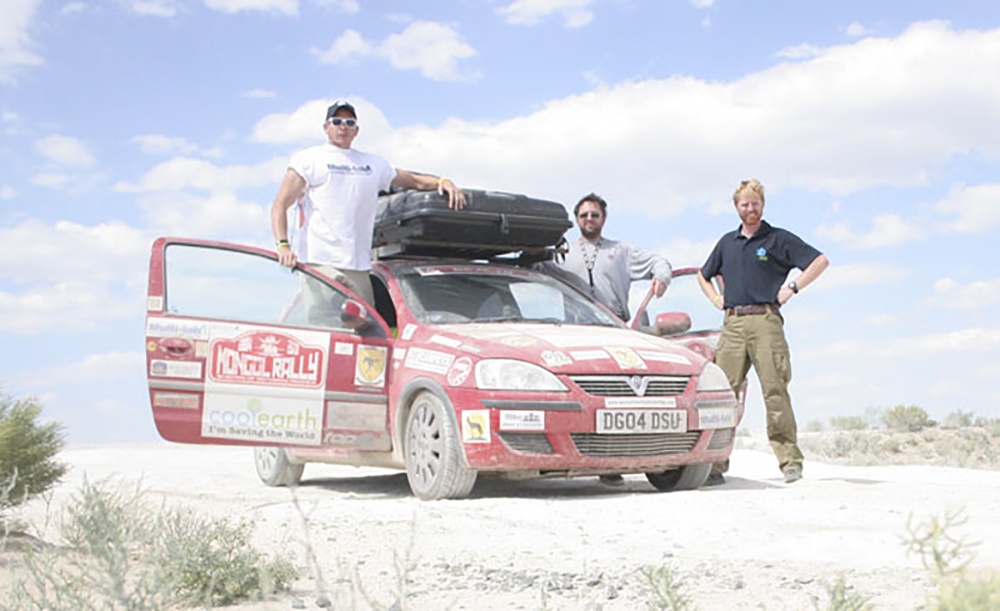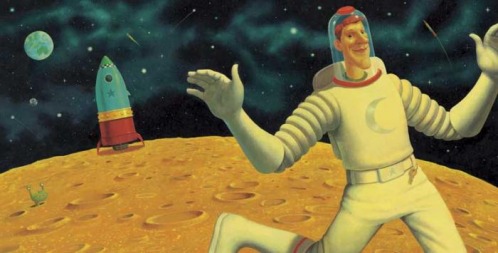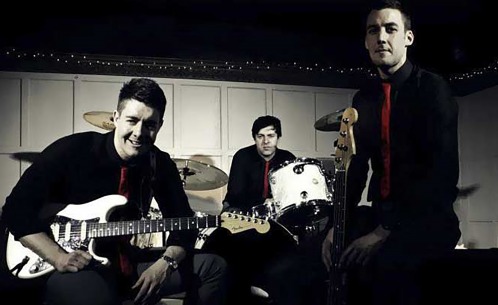Mongolia or Bust

Three men set off from the North East on an 8,000-mile, 27-day, 13-country rally to Mongolia in an inappropriately small car
Imagine leaving home one day in a 1.2-litre Vauxhall Corsa. Perhaps you’re going to the shops, or to pick up the kids. The usual. On the other hand, perhaps you’re going to drive all the way to Mongolia, across deserts, through rivers, over mountains and along some of the worst roads in the world, in a car better suited to the school run.
Sound crazy? Well, it did to us too, but an hour’s conversation with Kevin Robson (from Hexham, who undertook this epic challenge and filmed it all to make an hour-long documentary) was almost enough to make us want to throw off the shackles of our desk-based oppression and try it ourselves. Almost.
You can view their film, The Road To Mongolia, below, and then read on for our full interview:
Kevin (along with his friends Brian and David) didn’t come up with this trip on his own. He was taking part in the Mongol Rally, an annual event which sees hundreds of vehicles traveling from the UK and Europe to Mongolia. The rally is run by The Adventurists, and has ‘kind of gone down into folklore,’ says Kevin. The first time he heard of it was a story over a campfire, and he recalls that it seemed a fanciful, far off notion. But the rally is not without purpose. The teams raise money and awareness for good causes along the way, and once they reach the finish line in Ulaanbaatar their vehicles are auctioned off – both to raise money for charitable projects in Mongolia and to provide a much-needed injection of goods into Mongolia’s limited second-hand car market. ‘If you go to Mongolia you can buy a brand new Toyota Land Cruiser,’ Kevin explains. ‘But you couldn’t go in and buy a Corsa or a Peugeot or something like that – there’s no brand new mid-range vehicles. It’s either uber-expensive or it’s run down, beaten up Russian vehicles.’
The rally isn’t a race exactly. In fact, Kevin says, ‘If you get there first, you’ve done it wrong. It’s not about winning, it’s about the experience.’ Teams set off in mid-July, and they have as long as they like to reach Ulaanbaatar, by any route they choose. Once they’re out on the road, there’s no support. Some of the teams take the southern route (through southern Europe, Greece, Turkey Iran and across to Pakistan, eventually coming into Mongolia from China). Others choose to head north (up through Scandinavia, then down into Mongolia from Russia). Kevin and his team, knowing they had just 31 days before Brian had to be back at work, took a fairly central route.
Kevin and Brian met while backpacking in Australia around 15 years ago. Both strapped for cash, they ended up joint-owners of a camper van within a couple of months of meeting, and haven’t looked back since. Kevin and David were working together around Hexham at the time they did the rally, David and Brian meanwhile didn’t know each other. Kevin was the lynchpin in the threesome. ’They were totally relying on me that the other guy was sound,’ Kevin laughs. ‘But we got on incredibly well.’ Watching the film (available on You Tube and www.livingnorth.com) , the sense of camaraderie in the vehicle is clear.
It’s now two years since Kevin, Brian and David completed the rally, and the documentary has only just been completed. Kevin’s friend Paul had agreed to put together a short video when the group returned – but he wasn’t prepared for just how big a project it would turn out to be. Kevin arrived home with a terabyte of footage and thousands of images, and Peter soon realised there was enough for an hour-long documentary, rather than the five minute video he had been planning. The finished film is an enthralling watch – all terrible roads, vehicular malfunctions, long drives and big skies.
So far, so real-life Top Gear special. And in true Top Gear style, it wasn’t completely smooth running. There were times when Kevin and the team were genuinely afraid – be it for their vehicle, their chances of completing the race or their personal safety. ‘Some of the border crossings were absolutely atrocious,’ says Kevin. ‘We thought we were going to get the car impounded in places.’ At the Ukrainian border they narrowly escaped having to pay €4,500 import tax because the officials didn’t recognise their forms, and once they were in the country things didn’t improve – there was a run in with the police over a minor traffic offence where they ended up having to pay a bribe ($20 and some cigarettes) to get their documents back. ‘We’d been told if anybody does you favours, offer them cigars or cigarettes.’
The team stayed in campsites throughout Europe, and after that it often depended on security – they chose hotels with secure parking facilities. ‘We were going through parts of Russia where the police had submachine guns,’ Kevin explains. Some days they drove for so long they had no choice but to camp on the side of the road – grabbing four or five hours sleep before setting off again. The longest distance they covered in one go was 1,200 miles in 20 hours, from the Czech Republic down to central Romania. It’s a sign of how much the roads deteriorated that during their longest drive in terms of time they only covered 1,100 miles in 36 hours. That was in Kazakhstan. ‘Kazakhstan was very tough,’ Kevin says.
Kevin recalls that one of the best parts of the trip was actually staying at a campsite in the Altai Mountains, on the border between Russia and Mongolia. ‘This was the only campsite we’d hit between Romania and the edge of Mongolia,’ he says. He describes it as very Alpine, set among mountains with a huge river running through it. ‘We would have loved to have stayed there for a few days, but we were on a tight time schedule.’
All the teams work to different routes as well as schedules, but they can travel in convoy if they like. ‘Going through Europe you tend to see a few more teams,’ says Kevin, ‘but after Europe people are just scattered to the four winds.’ Driving through Kazakhstan they hardly saw another team – save for an incident where a car came tearing past where they were camping in the middle of the night, before promptly crashing off the road. Kevin could hear voices with English accents, but before he could reach where they had crashed they tore off again. ‘So we didn’t even get to meet up with them,’ he laughs.
There was little contact with home either. The team had a satellite text messaging service which they could use to update Facebook with their location and a short message, allowing people at home to follow their progress, but they couldn’t receive messages. ‘There was no two-way traffic on that thing,’ Kevin remembers. It wasn’t until they got home that they realised how attentively people were following their trip, and how much interest there was.
By the time they reached Ulaanbaatar, they had suffered nine punctures, broken the suspension on the car and almost lost the roof rack a few times – but they had done it. ‘It was really strange getting to Mongolia,’ says Kevin. With all the teams taking different routes and finishing at very different times, there was no grand finale. ‘It was almost an anticlimax,’ he laughs. ‘I had a real sense of wanting to continue, to keep moving. I didn’t need to, there was nothing I needed to get back for, it was just because I was in the mindset of getting somewhere.’ About 20 teams had finished in front of them, but the majority of people were still out on the road.
Kevin says he would certainly go back to Mongolia. ‘It’s a fantastic country, so special.’ Much of the population is nomadic, living in tents or yurts, but the modern world is starting to creep in. Kevin describes arriving in frontier-style villages where there are satellite dishes on the sides of the tents. ‘Places that were quite remote at one time are now changing,’ he says. ‘The rally is probably once in a lifetime, and I would definitely recommend doing it, but there’s so many other things out there to do. I probably wouldn’t repeat the same thing.’
That’s not to say he doesn’t have plans though. Kevin wants to return to Mongolia, even having completed the rally, he doesn’t feel that he’s seen all that this incredible country has to offer. ‘I’d probably just hire a Toyota Land Cruiser and go round the north of Mongolia,’ he says. So Kevin isn’t finished with Mongolia yet. But he might fly there next time.
For more information about the Mongol Rally and how it supports projects in Mongolia, go to www.theadventurists.com and www.adventuresfordevelopment.org. Kevin and the team were supporting BLUE Marine Foundation (www.bluemarinefoundation.com) and Cool Earth (www.coolearth.org).






